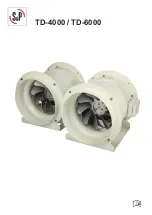
Roof fans –
RD/VD EC
Installation and Operating Instructions
EN
EN
2
maintenance work or before opening the terminal compartment:
- Isolate the device from the mains power supply!
- Wait for the rotating parts to come to a standstill!
- The unit must be secured against being switched on again!
• Once the rotating parts come to a standstill, a waiting time of 5 minutes
must be observed, as dangerous voltages may be present due to internal
capacitors, even after disconnection from the mains!
• Only transport roof fans using means of transport that are appropriate for the
weight. Wear protective gloves during transport!
• Wear gloves/protective footwear when unpacking the unit.
• Ensure the suitable load capacity and properties of the mounting surface
and use suitable mounting material.
• Depending on the fan size, ear protectors may be necessary when working
or standing near the running fan!
• All plant-related safety regulations must be observed! If applicable, further
country-specific regulations must also be observed!
• Protection against contact must be ensured pursuant to DIN EN 13857 in
the installed condition (section 1.6)! Contact with rotating parts must be
avoided.
• It must be ensured that there must be no persons, textiles or other materials
that could be sucked up, such as clothing, located in the intake area.
Furthermore, the outlet area must be kept free from objects and material that
could be ejected.
• Easy accessibility for inspection and cleaning personnel must be ensured, other
persons must not have access to the fan!
• A uniform inflow and free outlet must be ensured!
1�4 Area of application
Intended use:
The conveying of normal or slightly dusty (particle size < 10 μm), less aggressive and humid air, in mode-
rate climates at temperatures in the range of -20 °C to max +60 °C with stationary installation of the fan.
Installation: Horizontal on roofs (CHAPTER 3), inaccessible to unauthorised persons.
Reasonably foreseeable misuse:
The fans are not suitable for operation under difficult conditions, such as high levels of humidity, aggressive media,
long standstill periods, heavy contamination, excessive loads due to climatic, technical or electronic influences. The
same applies for the mobile use of fans (vehicles, aircraft, ships, etc.).
Improper, prohibited use:
- The conveying of explosive gas mixtures/media.
- Installation in a potentially explosive area/atmosphere.
- Operation without standardised safety devices (e.g. protection guard).
- The conveying of solids or solid content > 10 μm in the transport medium and liquids. Conveyance of abrasive
and/or media that is corrosive to fan materials.
- The conveying of greasy transport media.
- Vertical (hanging) installation of the roof fan.
1�5 Boundaries
Spatial boundaries:
A straight, flat pipe section or free suction must be ensured for the suction area. The outlet area must not be blocked.
A minimum distance of 1 m from the fan must be observed. The fan must be easily accessible for cleaning and main-
tenance purposes, particularly the terminal box/isolator switch.
Power supply interface:
– Connection only with permanently installed lines
– 3 PE or 1 phase + N + PE
– Control line
1�6 Protection against contact
The generally applicable safety at work and accident prevention regulations must be observed for installation!
The operator is responsible for observing these regulations!
– Contact with rotating parts must be avoided. It must be ensured that there must be no persons, textiles or other
materials that could be sucked up, such as clothing, located in the intake area.
– Protection against contact may be necessary on the suction side depending on the installation conditions.
– Fans which are protected by their installation method (e.g. installation in ventilation ducts or closed assemblies) do
m
WARNING
















































